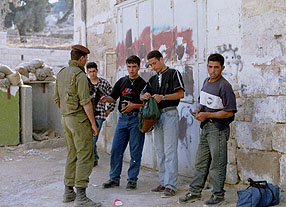
Adli drove us to the residences of the Christian Peacemaker Team (CPT) in Hebron, where our mission was to go up on the roof where we could see and photograph the Jewish settlements that exist in the center of the city. On the way into the building, two Israeli soldiers were searching all Palestinians passing down the street (left).
I photographed this and we carried on up onto the roof, where the view was amazing. Glancing down, I noticed that since we had left, the soldiers were now making groups of young kids stand with arms spread out, up against the wall (below, click for 57K enlargement).
This phenomenon is, in fact, the point of the CPT's mission in Hebron, a "violence reduction presence" in the city at the invitation of the Palestinian municipality. A mysterious figure in sunglasses was, meanwhile, photographing us from a roof in another settlement. Probably from one of Israel's security agencies.

CPT volunteers have been coming to live in Hebron since July 1995 to both discourage violence by their physical presence as witnesses and by documenting and publishing what they witness.
They have an e-mailing list, also available as an archive on the CPT website, that includes some well-written stories that you don't see in the news, including:

If Christian peacemaking has ever sounded a little too pious for your taste these people - who risk their lives in the streets of Hebron in an attempt to protect Palestinians and draw attention to their plight - should be a suitable anecdote. The eyes of the boy in the photo on the left speak a clear message about the sowing of violence here.
Anecdote too to the pervading, Ra! Ra! State-of-Israel-whatever-it-does!, Christian Zionist heresy that many American Christians seem to undiscerningly swallow in the same way they do with hamburgers, mistakenly thinking it to be food.
For those interested, biblical support for criticism of Israel can be found in - well, take your pick from a selection of almost every major and minor Old Testament prophet - Moses, Samuel, Isaiah, Jeremiah, Ezekiel, Joel, Amos, and Malachi, just for starters.

As we are looking down at the shabab below being made to stand spread-eagled against the wall, and I take a few photographs, Diane Row, from CPT comes out to greet us.
She invites us downstairs where the team has set up an office, with a phone, computer and maps all over the wall. A banner is spread out against one wall, declaring, "The nonviolent power of the people is stronger than mighty armies."
We meet other members of the team, including Kathi Kern, a Christian author who was attacked by settlers wanting to take her camera in September 1995.
Two months later, on 4 November 1995, Diane was also attacked. Settlers were gathered outside a Palestinian school, where the atmosphere was tense and the schoolchildren were terrified. Diane was talking to two sisters, a 14 and an 18-year-old.
Settler kids aged between 10-12 told them to leave. They refused and the settler kids kicked the older sister and knocked Diane down. Her glasses fell off and the younger sister tried to come to their help.
The settler kids began to drag this sister down the road by her braided hair, until soldiers intervened to stop them. Note, stop them, not punish them.

It is to the maps on the wall that Diane draws our attention (left), showing the various boundaries imposed by redeployment in Hebron.
The Palestinian Authority controls H1, which accounts for perhaps 80 percent of the city, where 100,000 Palestinians live.
Israel controls H2, where 20,000 Palestinians and a few hundred settlers live. This section encompasses the centre of town, including the Old City of Hebron.
"People have said that the Palestinians got the gate to the city while the Israelis got the city," says Diane. The proximity of the two parties in the conflict, the "ingredients" of the map certainly are a recipie for disaster.